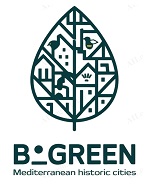The main expected outcomes are three, an Action Plan (to be disseminated in the form of Guidelines) for enhancing biodiversity, a set of physical demonstrators and a Digital Platform to monitor the historical core ecosystem and biodiversity, which in turn serves as a Knowledge Hub for the project results and knowledge generated. These outcomes are the result of other mid-stage outputs related to the phases of the project, as listed below:
1. Parameter analysis. B_Green analyses and obtains urban data from a parametric framework fed with data by each HC. Indicators of the urban fabric, urban spaces, and environment are compiled and analysed. To do this, partners obtain data for the four HCs based on building typologies, which helps us characterise the buildings’ shape through a common set of indicators (Itecons). Secondly, researchers analyse urban space and green areas indicators, with social and spatial practices and NBS characteristics (UNINA). Finally, the team will obtain biodiversity indicators based on the specificities of the assessment; species presence, temperature, pollution, and most significant types of urban habitat (UJI).
2. Correlation of data. At an intermediate stage, the project evaluates and combines the parametric data through mapping to generate patterns using a 2D GIS interface (CyI). Interactive Maps of HCs are produced to correlate the biodiversity assessment with the urban morphology (building and open spaces), to define specific urban habitats‘ models where biodiversity and naturalisation measures have plausible possibilities of success. The platform created to correlate these data serves to undertake citizen-sensing actions (4th output).
3. An Action Plan complementary to the existing protection and management regulations, seeking a holistic and integrated vision of specific areas in the HCs under study. Its outcomes propose biodiversity and naturalisation measures to promote greener spaces. This is done by grounding the results obtained from the parametric analysis in the four cases. The Action Plan, co-created through locals‘ participation in the second part of the project (4th output), defines areas of particular interest, and measures’ implementation. The Action Plan is drafted from the simulation of intervention scenarios in habitats through naturalisation measures – by means of the proposed digital platform- (CyI & UJI), and from the review of naturalisation and NBS solutions in the European context (UNINA & Itecons).
4. Transfer of knowledge. Citizens and researchers co-design, share and disseminate the research and its results on-site, on-line and in other similar HCs through an international seminar involving CIVVIH members and OWHC City councils. B_Green proposes placemaking activities in planning and biodiversity concepts to share experiences and knowledge for well-being (section 6.1). This takes place in the form of B_Green Urban Living Labs and a Knowledge Hub (see Section 5).
B_Green establishes synergies with similar ongoing projects such as Naturo DUT 2022, which develops a strategic framework, including a process and methodology, for capacity building and empowerment of both local governments and civil society stakeholders to co-create nature-based solutions (NBS) SLU project granted funding from the Driving Urban Transition (DUT) program | Externwebben. Another interesting potential partner is the Urban Biodiversity Project (HOME (urbanbiodiversityproject.com) which have interesting initiatives such as the „'Rewilding rave' helping to connect locals with nature”. Other synergies with academics and stakeholders of current and past projects in which the B_Green team has had the chance to collaborate are: GREEN FUTURE, GREEN URBAN LIVING, Nature for sustainable cities, PHUSICOS According to nature, The HE Translaighthouses, URBAN Periscope Project, or Writing Historic Centres, among others (please, see the list of references for more detail).
